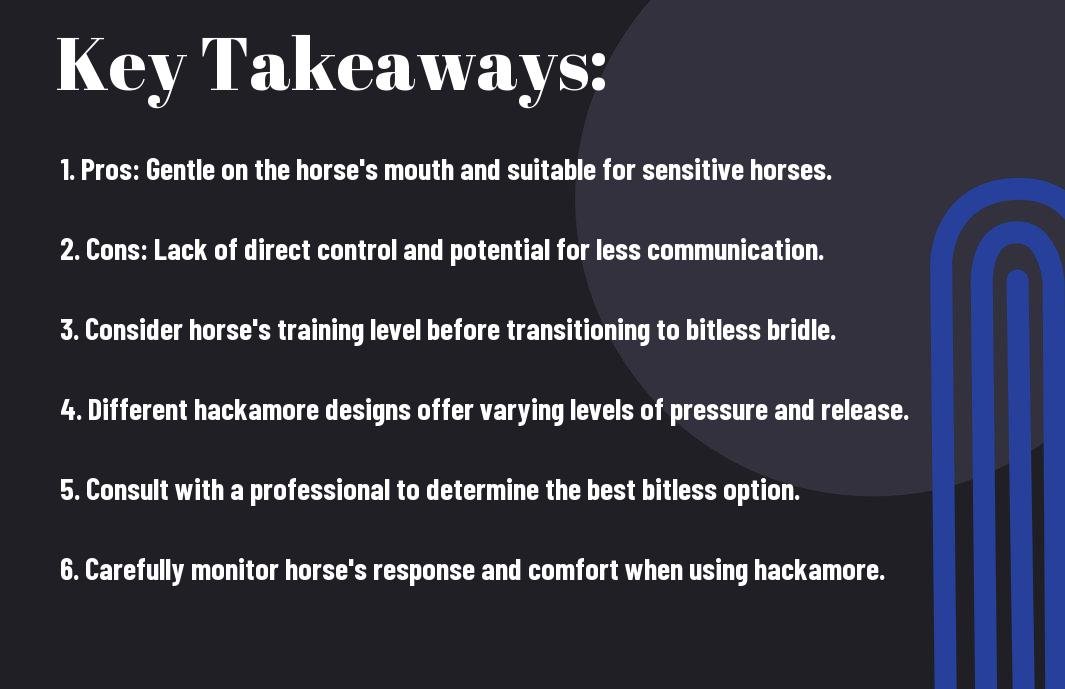Pros and Cons Using a Hackamore – Navigating Bitless Bridle Options
- Home
- Pros and Cons Using a Hackamore – Navigating Bitless Bridle Options

Pros and Cons Using a Hackamore – Navigating Bitless Bridle Options
Ruminating on the myriad of bitless bridle options available to equestrians can be both exhilarating and overwhelming. As an experienced rider and trainer, I have found that the hackamore is one of the most popular and divisive choices when it comes to bitless bridles. On one hand, the hackamore can provide a gentler alternative to traditional bits, making it a popular choice for sensitive horses or riders looking to avoid potential mouth discomfort. However, it is important to weigh the potential drawbacks and dangers of using a hackamore, as the lack of bit pressure can lead to decreased control and communication with your horse, especially in high-energy or challenging situations. In this blog post, I will guide you through the pros and cons of using a hackamore, helping you navigate the world of bitless bridle options to make the best choice for you and your equine partner.
Key Takeaways:
- Pros of Using a Hackamore: Hackamores provide a gentler option for horse training and can be a useful tool for horses with dental issues or sensitive mouths.
- Cons of Using a Hackamore: Some horses may not respond well to hackamores, and they may not provide the same level of control as a traditional bit.
- Consider Individual Horse Needs: It’s important to evaluate your horse’s specific needs and preferences when deciding whether to use a hackamore.
- Training and Transition: Transitioning from a bit to a hackamore may require additional training for both the horse and the rider to ensure a smooth and successful transition.
- Explore Bitless Bridle Options: There are many different types of bitless bridles available, so it’s important to explore and consider all options before making a decision for your horse.
Understanding Bitless Bridle Options
A bitless bridle is a type of headgear for a horse that does not use a bit. Instead, it uses pressure applied to the horse’s face, nose, and jaw to control the animal. There are several different types of bitless bridles, each with its own design and method of applying pressure.
Exploring Different Types of Hackamores
There are several types of hackamores available on the market, each with its own unique design and method of applying pressure to the horse’s face and nose. Some common types of hackamores include:
- Bosal: A bosal hackamore consists of a noseband made of rawhide or other stiff material, with a long mecate rein attached to the heel knot.
- Mechanical Hackamore: A mechanical hackamore has shanks on the side of the horse’s head and a curb chain, which creates pressure when the reins are pulled.
- Side Pull: A side pull hackamore is a bitless bridle that has a flat noseband and rings on either side, to which the reins are attached.
- Bitless Bridle with Crossunder Straps: This type of hackamore has a noseband and two sets of reins that cross under the horse’s chin, applying pressure when the reins are pulled.
- Indian Bosal and Arabian Hackamore: These types are used similarly, but their design and the region from which they originate differ greatly.
Any type of hackamore should be adjusted properly to avoid unnecessary pressure and discomfort for the horse. Proper fitting and adjustment are essential to ensure the safety and comfort of the horse while riding or training.
Comparing Pros and Cons of Bitless Bridle Options
When considering the use of a bitless bridle, it is important to weigh the pros and cons of each option carefully. Here are some of the pros and cons to consider:
| Pros | Cons |
| Gentler on the horse’s mouth and face | May have less precise control than a bit |
| Reduces the risk of mouth and tongue injuries | May not be suitable for all disciplines |
| Can be a good option for horses with dental issues | Requires proper fitting and adjustment for effective control |
| Encourages better communication and partnership between rider and horse | Some horses may not respond well to bitless bridles |
| May provide a more natural and comfortable riding experience for the horse | May require retraining for horses accustomed to a bit |
It’s important to carefully consider your horse’s needs, your riding discipline, and your own comfort and experience when choosing a bitless bridle option. Each horse is unique, and what works well for one horse may not work for another. By weighing the pros and cons and considering your horse’s individual needs, you can make an informed decision about using a bitless bridle.
Transitioning to a Hackamore
Obviously, transitioning to a hackamore from a traditional bit can be a big adjustment for both you and your horse. It’s important to take it slow and give your horse time to get used to the new sensation and cues. Start by introducing the hackamore in a controlled environment, such as an enclosed arena, and allow your horse to become familiar with the feel of the hackamore without the distractions of the outside world. Gradually introduce it on trail rides or in other settings as your horse becomes more comfortable.
Training Techniques for Using a Hackamore
When transitioning to a hackamore, it’s important to remember that the cues are different than with a traditional bit. I recommend starting with basic groundwork exercises to establish clear communication between you and your horse. Practice lateral flexion and backing up, using light, consistent cues to help your horse understand the pressure points of the hackamore. As your horse becomes more responsive, you can begin working under saddle, focusing on soft and subtle cues to encourage your horse to respond to the hackamore.
Addressing Potential Challenges
While there are many benefits to using a hackamore, it’s important to acknowledge potential challenges that may arise during the transition period. Some horses may initially resist the change and exhibit frustration or confusion. If this happens, it’s crucial to remain patient and consistent in your training approach. Additionally, some horses may have physical issues that make using a hackamore uncomfortable. Always consult with a qualified equine professional if you have concerns about your horse’s response to the hackamore.
Maximizing the Benefits of Using a Hackamore
Not all bitless bridles are created equal, and using a hackamore can offer a number of advantages for both you and your horse. By understanding how to maximize the benefits of using a hackamore, you can ensure a positive and effective riding experience.
Improving Communication and Responsiveness
When properly fitted and used, a hackamore can improve communication between you and your horse. The pressure applied by the hackamore on the nose and chin can be more direct and precise, allowing for clearer signals and cues. This can lead to greater responsiveness from your horse, making it easier to communicate your intentions and expectations while riding. By improving communication, the hackamore can also help foster a stronger bond and understanding between you and your equine partner.
Enhancing Comfort and Physical Well-being
Compared to a traditional bit, a hackamore can offer enhanced comfort for your horse. The absence of a bit in the mouth can reduce the potential for oral discomfort, pain, and injury. This can be particularly beneficial for horses with sensitive mouths or dental issues. Additionally, the design of a hackamore distributes pressure more evenly across the nose and chin, which can help minimize the risk of physical strain or discomfort during riding. By prioritizing your horse’s comfort and physical well-being, you can create a more positive and enjoyable experience for both of you.

Conclusion
Drawing together the various pros and cons of using a hackamore, it is clear that this bitless bridle option offers a unique set of benefits and drawbacks. While it provides a gentler and more direct form of communication between horse and rider, it may lack the precise control and finesse that a traditional bit can offer. Ultimately, the decision of whether to use a hackamore or not comes down to individual horse and rider preferences, as well as the specific needs of the situation at hand. As I have discussed, it is crucial to carefully consider your horse’s behavior, training, and anatomy, as well as your own riding style, before making a decision on bitless bridle options. By weighing the pros and cons, you can make an informed choice that best suits the needs of both you and your horse.
FAQ
Q: What is a hackamore and how does it work?
A: A hackamore is a type of bitless bridle that uses pressure on the horse’s nose, chin, and poll instead of in its mouth. It works by applying pressure to different areas of the horse’s head to communicate signals and cues.
Q: What are the pros of using a hackamore?
A: Using a hackamore can provide a more comfortable and natural experience for the horse, as it removes the potential for discomfort or pain caused by a bit. It can also encourage better head carriage and promote a softer, more responsive ride.
Q: What are the cons of using a hackamore?
A: One potential disadvantage of using a hackamore is that it may not offer the same level of precise communication and control as a bit. Additionally, not all horses may respond well to a hackamore, so it’s important to consider individual preferences and needs.
Q: What are the different types of hackamores available?
A: Some common types of hackamores include mechanical hackamores, bosals, side pull hackamores, and cross-under hackamores. Each type offers unique features and pressure points, so it’s important to carefully consider which option would best suit your horse’s needs and your riding style.
Q: How do I choose the right hackamore for my horse?
A: When choosing a hackamore, it’s important to consider factors such as your horse’s level of training, sensitivity, and behavior. Additionally, seeking guidance from a professional trainer or equine specialist can help ensure that you select the right type of hackamore for your horse.
- Share
Mark Twain
Mark Twain stands at the helm of Create More Flow, infusing every sentence with the wisdom of his 15-year expeience through the seas of SEO and content creation. A former BBC Writer, Mark has a knack for weaving simplicity and clarity into a tapestry of engaging narratives. In the realm of content, he is both a guardian and a guide, helping words find their flow and stories find their homes in the hearts of readers. Mark's approach is grounded in the belief that the best content feels like a chat with an old friend: warm, inviting, and always memorable. Let Mark's expertise light up your website with content that's as friendly to Google as it is to your audience. Each word is chosen with care, each sentence crafted with skill - all to give your message the human touch that both readers and search engines love.
